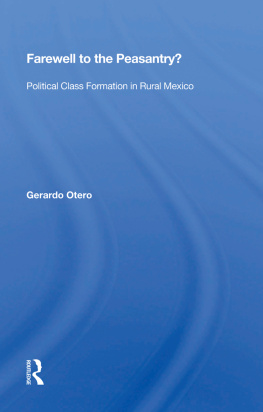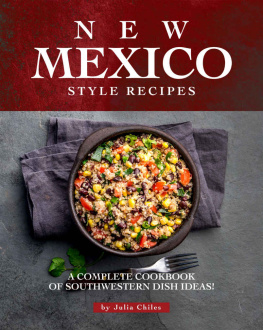
William Carleton tells a richly textured story of New Mexican agriculture that sheds new light on the rise of modern industrial agriculture in the twentieth century. In particular, he shows in fascinating detail how industrial agriculture often incorporated traditional elements and therefore how misleading those labels can be.
William Thomas Okie, author of The Georgia Peach: Culture, Agriculture, and Environment in the American South
Extremely important.... Fruit, Fiber, and Fire is a significant contribution to the fields of New Mexico history, Southwest history, agricultural history, historical geography, cultural history, and borderlands history.
Sterling Evans, author of Bound in Twine: The History and Ecology of the Henequen-Wheat Complex for Mexico and the American and Canadian Plains, 18801950
Fruit, Fiber, and Fire
A History of Modern Agriculture in New Mexico
William R. Carleton
University of Nebraska Press | Lincoln
2021 by the Board of Regents of the University of Nebraska
Cover designed by University of Nebraska Press; cover images iStock.com: apples: Halyna Hryshchenko; cotton: Inna Sinano; peppers: KaterinaKr; background: MichaelDeLeon.
An earlier version of chapter 4 was published in New Mexico Historical Review 94, no. 4 (Fall 2019): 33150. Copyright 2019 by the University of New Mexico Board of Regents. All rights reserved.
An earlier version of chapter 5 was published in Matt Garca, E. Melanie DuPuis, and Don Mitchell, eds., Food Across Borders (New Brunswick NJ : Rutgers University Press, 2017), 10520. Used with permission.
All rights reserved.
Library of Congress Cataloging-in-Publication Data
Names: Carleton, William R., author.
Title: Fruit, fiber, and fire: a history of modern agriculture in New Mexico / William R. Carleton.
Description: Lincoln: University of Nebraska Press, [2021] | Includes bibliographical references and index.
Identifiers: LCCN 2020042839
ISBN 9781496216168 (hardback)
ISBN 9781496226969 (epub)
ISBN 9781496226983 (pdf)
Subjects: LCSH : AgricultureNew MexicoHistory20th century. | ApplesNew MexicoHistory20th century. | CottonNew MexicoHistory20th century. | PeppersNew MexicoHistory20th century.
Classification: LCC S 451. N 6 C 375 2021 | DDC 338.109789dc23
LC record available at https://lccn.loc.gov/2020042839
The publisher does not have any control over and does not assume any responsibility for author or third-party websites or their content.
Contents
In the fall of 2007 I cleared out an overgrown half-acre twenty miles north of Albuquerque of willows, elms, and various annual weeds, and planted a few rows of garlic that I planned to sell the following summer. Though full of energy, earnestness, and enthusiasm, I lacked an intimate knowledge of the landscape and faced a steep learning curve on how to grow vegetables there. Over the course of several sweaty months and years, I eventually expanded the garden and learned the ins and outs of managing a small farm business. As I sought to learn how to grow vegetables in the arid climate, my mind often wandered to the regions agricultural history. How have other farmers done it? What did they grow, and why? Though I gleaned what I could from a small number of lay books, I could not find a scholarly history of recent commercial agriculture in New Mexico that could answer many of my questions. This project, in part, sprang from the seed of that quest. My hope is that within these pages lie some useful details for local farmers and local food advocates, that I provide some kindling for their further research, and that I offer them an overall sense of how rich and diverse an agricultural history this region has experienced over the long twentieth century.
This book, however, strives to tell a history that will interest many more people than just the curious farmers out there. My intended audience goes well beyond the farming community to include all those interested in the broader cultural and environmental history of the twentieth-century New Mexico borderlands and how that history fits into even broader national and global narratives.
To tell this story I have relied on the help of a long list of people. First, to all those who read and commented on previous drafts of this book, I owe an enormous debt of gratitude. I especially want to thank my dissertation adviser, Virginia Scharff, and my dissertation committee members, Samuel Truett, Luis Campos, and Jared Farmer. Without their input and support this book would not have happened. I am grateful, too, to the two anonymous reviewers who provided highly instructive and helpful comments. This is a better book because of the time they took.
Individual chapters have also been strengthened by a host of generous scholars. I owe all the members of the Food Across Borders symposium, sponsored by the William P. Clements Center for Southwest Studies at Southern Methodist University, much thanks for their input on chapter 5. I would also like to thank the members of the 2015 Western History Dissertation Workshop hosted at Yale University, and the members of the 2015 Workshop on the History of the Environment, Agriculture, Technology, and Science hosted at the University of ColoradoBoulder, all of whom provided challenging insights for chapters 1 and 2, respectively. I also remain grateful to Dr. Deborah Fitzgerald, who provided comments on what became chapter 3 for a panel at the 2016 American Society for Environmental History annual meeting in Chicago.
Many others have helped along the way. Many thanks for all the help from archivists at the Center for Southwest Research, at NMSU , and at the New Mexico Farm and Ranch Heritage Museum; and to Gordon Tooley, who spent a fruitful day with me early in my research planting trees, talking apples, and sharing articles from his personal library. I am grateful to the crew at the New Mexico Historical Review, under the leadership of Dr. Durwood Ball, for the camaraderie and support they provided along the way. I am highly indebted to Bridget Barry and the entire editorial team at the University of Nebraska Press, and to Vicki Low for such thoughtful and careful copy edits. Thank you, as well, to Marisa Thompson, who let me crash in her guestroom for all those research visits to Las Cruces. Most of all, I am grateful for my family, who helped me along in too many ways to count.
As perhaps you have noticed, it has become difficult to dissociate New Mexico from its iconic chile pepper. For many, the very notion of New Mexico might bring to mind the smell of roasting green chiles in the fall, the sight of red chile wreaths and ristras hanging beside adobe walls, or the burn in the chest from a pungent dish of carne adovada. Today the ubiquitous imagery of the chileemblazoned on license plates and billboards, on airport T-shirts and souvenir shop mugshas become so identified with New Mexico that it nearly serves as a synonym for the state. But, as the following pages reveal, such unequivocal status has taken time to develop; along the way, other crops have held reign over the Land of Enchantment. This is a history of how these shifting crops reflect deeper change, and how the iconic crops of long-ago harvests can, through careful attention, continue to bear valuable lessons on the greater historical narratives of our past.
At the core of my decision to hone in on specific crops is my conviction that to understand the history of a people, we must understand the history of the plants that have sustained them. In New Mexico perhaps no crops have defined the people and their landscape in the industrial era more than apples, cotton, and chile. These crops together illustrate how agriculture has spurred migrations of plants and people, and, in turn, shaped the culture of the place. The physical origins, the shifting cultural meanings, and the environmental and market requirements of these three iconic plants all broadly point to the convergence in New Mexico of larger regionsthe Mexican North, the American Northeast, and the American Southand of diverse regional attitudes toward industry in agriculture.
Next page




